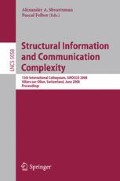Abstract
Consider a system composed of n sensors operating in synchronous rounds. In each round an input vector of sensor readings x is produced, where the i-th entry of x is a binary value produced by the i-th sensor. The sequence of input vectors is assumed to be smooth: exactly one entry of the vector changes from one round to the next one. The system implements a fault-tolerant averaging consensus function f. This function returns, in each round, a representative output value v of the sensor readings x. Assuming that at most t entries of the vector can be erroneous, f is required to return a value that appears at least t + 1 times in x. The instability of the system is the number of output changes over a random sequence of input vectors.
Our first result is to design optimal instability consensus systems with and without memory. Roughly, in the memoryless case, we show that an optimal system is D 0, that outputs 1 unless it is forced by the fault-tolerance requirement to output 0 (on vectors with t or less 1’s). For the case of systems with memory, we show that an optimal system is D 1, that initially outputs the most common value in the input vector, and then stays with this output unless forced by the fault-tolerance requirement to change (i.e., a single bit of memory suffices).
Our second result is to quantify the gain factor due to memory by computing c n (t), the number of decision changes performed by D 0 per each decision change performed by D 1. If \(t=\frac{n}{2}\) the system is always forced to decide the simple majority and, in that case, memory becomes useless. We show that the same type of phenomenon occurs when \(\frac{n}{2}-t\) is constant. Nevertheless, as soon as \(\frac{n}{2}-t \sim \sqrt{n}\), memory plays an important stabilizing role because the ratio c n (t) grows like \(\Theta(\sqrt{n})\). We also show that this is an upper bound: \(c_n(t)=O(\sqrt{n})\) for every t.
Our results are average case versions of previous works where the sequence of input vectors was assumed to be, in addition to smooth, geodesic: the i-th entry of the input vector was allowed to change at most once over the sequence. It thus eliminates some anomalies that ocurred in the worst case, geodesic instability setting.
Access this chapter
Tax calculation will be finalised at checkout
Purchases are for personal use only
Preview
Unable to display preview. Download preview PDF.
References
Berman, P., Garay, J.: Cloture votes: n/4-resilient distributed consensus in t+1 rounds. Math. Sys. Theory 26(1), 3–19 (1993)
Chandrakasan, A.P., Brodersen, R.W.: Low power digital CMOS design. Kluwer Academic Publishers, Dordrecht (1995)
Davidovitch, L., Dolev, S., Rajsbaum, S.: Stability of Multi-Valued Continuous Consensus. SIAM J. on Computing 37(4), 1057–1076 (2007); Extended abstract appeared as Consensus Continue? Stability of Multi-Valued Continuous Consensus! In: 6th Workshop on Geometric and Topological Methods in Concurrency and Distributed Computing, GETCO 2004 (October 2004)
Dolev, S.: Self-Stabilization. The MIT Press, Cambridge (2000)
Dolev, S., Rajsbaum, S.: Stability of Long-lived Consensus. J. of Computer and System Sciences 67(1), 26–45 (2003); Preliminary version in Proc. of the 19th Annual ACM Symp. on Principles of Distributed Computing, (PODC 2000), pp. 309–318 (2000)
Diaconis, P., Shahshahani, M.: Generating a random permutation with random transpositions. Probability Theory and Related Fields 57(2), 159–179 (1981)
Ehrenfest, P., Ehrenfest, T.: Ueber zwei bekannte EingewÃd’nde gegen das Boltzmannsche H-Theorem. Zeitschrift für Physik 8, 311–314 (1907)
Kahn, J., Kalai, G., Linial, N.: The Influence of Variables on Boolean Functions. In: Proc. of the IEEE FOCS, pp. 68–80 (1988)
Kramer, B., Fussenegger, M.: Hysteresis in a synthetic mammalian gene network. Proc. Natl. Acad. Sci. USA 102(27), 9517–9522 (2005)
Kutten, S., Masuzawa, T.: Output Stability Versus Time Till Output. In: Pelc, A. (ed.) DISC 2007. LNCS, vol. 4731, pp. 343–357. Springer, Heidelberg (2007)
Kopetz, H., Veríssimo, P.: Real Time and Dependability Concepts. In: Mullender, S. (ed.) Distributed Systems, ch. 16, pp. 411–446. ACM Press, New York (1993)
Musoll, E., Lang, T., Cortadella, J.: Exploiting the locality of memory references to reduce the address bus energy. In: Proc. of the Int. Symp. on Low Power Electronics and Design, August 1997, pp. 202–207 (1997)
Norris, J.R.: Markov Chains. Cambridge Series in Statistical and Probabilistic Mathematics. Cambridge University Press, Cambridge (1998)
Palacios, J.L.: Another Look at the Ehrenfest Urn via Electric Networks. Advances in Applied Probability 26(3), 820–824 (1994)
Pomerening, J., Sontag, E., Ferrell, J.: Building a cell cycle oscillator: hysteresis and bistability in the activation of Cdc2. Nature Cell Biology 5, 346–351 (2003)
Su, C.-L., Tsui, C.-Y., Despain, A.M.: Saving power in the control path of embedded processors. IEEE Design & Test of Comp., 24–30 (1994)
Author information
Authors and Affiliations
Editor information
Rights and permissions
Copyright information
© 2008 Springer-Verlag Berlin Heidelberg
About this paper
Cite this paper
Becker, F., Rajsbaum, S., Rapaport, I., Rémila, É. (2008). Average Binary Long-Lived Consensus: Quantifying the Stabilizing Role Played by Memory. In: Shvartsman, A.A., Felber, P. (eds) Structural Information and Communication Complexity. SIROCCO 2008. Lecture Notes in Computer Science, vol 5058. Springer, Berlin, Heidelberg. https://doi.org/10.1007/978-3-540-69355-0_6
Download citation
DOI: https://doi.org/10.1007/978-3-540-69355-0_6
Publisher Name: Springer, Berlin, Heidelberg
Print ISBN: 978-3-540-69326-0
Online ISBN: 978-3-540-69355-0
eBook Packages: Computer ScienceComputer Science (R0)

